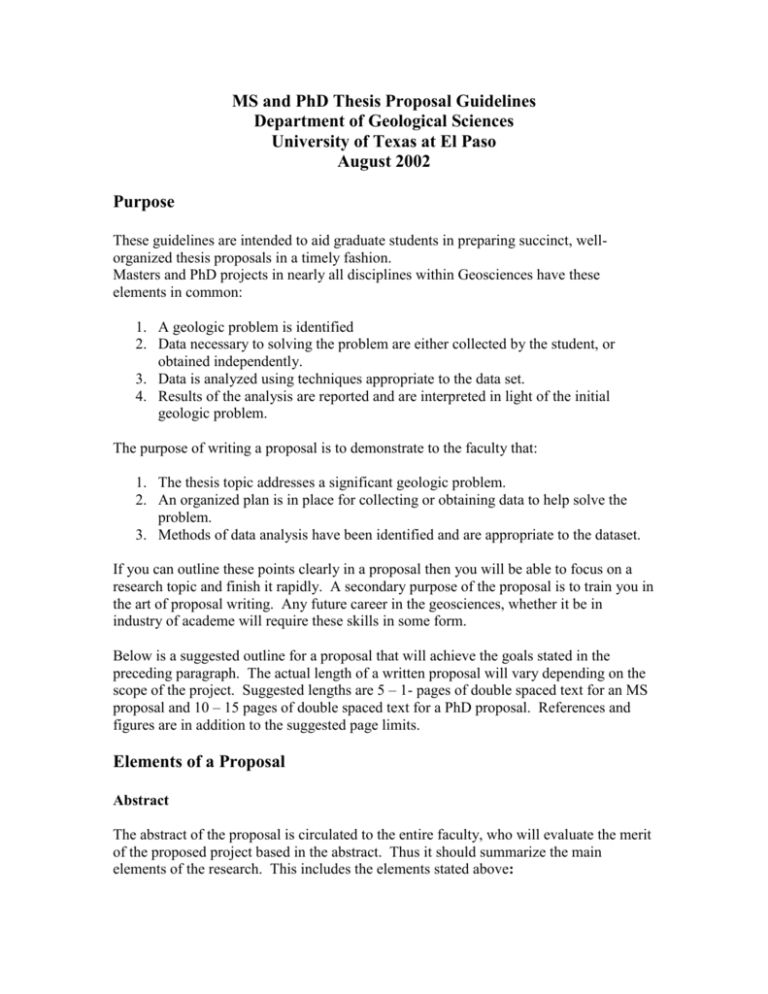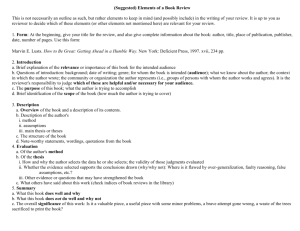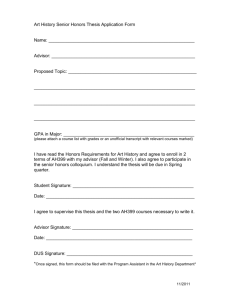MS and PhD Thesis Proposal Guidelines
advertisement

MS and PhD Thesis Proposal Guidelines Department of Geological Sciences University of Texas at El Paso August 2002 Purpose These guidelines are intended to aid graduate students in preparing succinct, wellorganized thesis proposals in a timely fashion. Masters and PhD projects in nearly all disciplines within Geosciences have these elements in common: 1. A geologic problem is identified 2. Data necessary to solving the problem are either collected by the student, or obtained independently. 3. Data is analyzed using techniques appropriate to the data set. 4. Results of the analysis are reported and are interpreted in light of the initial geologic problem. The purpose of writing a proposal is to demonstrate to the faculty that: 1. The thesis topic addresses a significant geologic problem. 2. An organized plan is in place for collecting or obtaining data to help solve the problem. 3. Methods of data analysis have been identified and are appropriate to the dataset. If you can outline these points clearly in a proposal then you will be able to focus on a research topic and finish it rapidly. A secondary purpose of the proposal is to train you in the art of proposal writing. Any future career in the geosciences, whether it be in industry of academe will require these skills in some form. Below is a suggested outline for a proposal that will achieve the goals stated in the preceding paragraph. The actual length of a written proposal will vary depending on the scope of the project. Suggested lengths are 5 – 1- pages of double spaced text for an MS proposal and 10 – 15 pages of double spaced text for a PhD proposal. References and figures are in addition to the suggested page limits. Elements of a Proposal Abstract The abstract of the proposal is circulated to the entire faculty, who will evaluate the merit of the proposed project based in the abstract. Thus it should summarize the main elements of the research. This includes the elements stated above: 1. The geologic problem and its significance 2. A description of the data to be acquired or analyzed 3. A description of data analysis methods An abstract is typically one to two paragraphs in length and should be written after you have completed the rest of the proposal. Introduction In many ways an introduction is an expanded version of the abstract. As such it should include: 1. any background material necessary to motivate the investigation of the chosen geologic problem 2. discussion of the significance of the problem 3. a brief summary of the data series and analysis methods An introduction is typically three to four paragraphs long. Background A summary of previous work and results is important to demonstrating the significance of the problem to be addressed in the thesis. It is an opportunity to show what is known and unknown in the chosen field of research. A large amount of reading is usually required to prepare for writing the background section of a proposal. It is extremely important to a well written proposal to recognize which parts of this background material are fundamental to the proposed thesis research. For example, if the thesis topic is Holocene stream deposits in El Paso County, it is probably not necessary to write five pages on the tectonic history of the southwestern U.S. and northern Mexico from the Precambrian to the present. A two-page review of Tertiary tectonism and local stratigraphy is probably sufficient. All previous work should be appropriately cited in the text. Data In the geoscience thesis datasets commonly come in two forms: 1.) Data to be collected; 2.) Data in hand. Geology and geochemistry theses tend to fall in the “to be collected” category. In this case, the data section of the proposal should discuss the type of data to be collected and the methods for data collection. For example, in a geochemistry thesis, data are collected by conducting laboratory experiments. Thus the data section of the proposal should describe the laboratory experiments and the type of data will result. In field-oriented theses, the data consist of sample collection, this section analysis, strike and dip measurements, etc. Geophysics theses typically fall in the “in hand” category. In this case, the data section should describe the available data and explain how they will solve the geologic problem identified in the introduction. Analysis This section should describe the approach(es) that will be used to analyze and reduce the data. This may consist of as little as making a few graphs or maps of results, to elaborate computer data reduction and modeling schemes. This is an extremely important part of the proposal, since it strongly affects the ultimate interpretation of the data. In writing this section, you should strive to show that the chosen analysis scheme will permit the best interpretation of the dataset. Summary This section is meant to remind the reader of the main goals of the research. Thus it should briefly review research objectives and the methods that will be used to meet those objectives. References Any proposal must include a detailed list of references, which tells the reader where to look for articles cited in the text. The references should follow a consistent format such as that used in geoscience journals. Use the referencing style from a journal in your specialty, for example, Journal of Geophysical Research, Geological Society of America, Geochimica et Cosmochimica Acta, etc. Figures A picture is worth a thousand words. Figures serve to illustrate important aspects of the background material, sample data, and analysis techniques. A well chosen and well labeled figure can reduce text length, and improve proposal clarity. Proposals often contain figures from other articles. These can be appropriate, but you should consider modifying them if the modifications will improve your point. Modern computer technology such as scanners and drafting programs are available in the department to help do this. Grammar and Spelling Poor grammar and spelling detract from the content of the proposal. The reader focuses on the grammar and spelling problems and misses key points made in the text. Modern word processing programs have grammar and spell checkers. Use them. Have a fellow student read through your proposal for errors before you submit it to the faculty. Consult your advisor These are general guidelines. See your principle advisor for additional recommendations regarding the format and content of your proposal. Your principle advisor should review a first draft of the proposal before you give copies to other committee members. Approval Procedures Every graduate student is given a deadline for submitting a proposal signed by the committee to the department. You should see that the committee receives the proposal at least three weeks before the deadline. Do not give a draft of your proposal to your committee the day before the due date and expect them to read and approve it immediately. Your principle advisor and other committee members have many other obligations. If you do not allow them sufficient time to review the proposal, you may end up suffering the consequences of a missed deadline.






